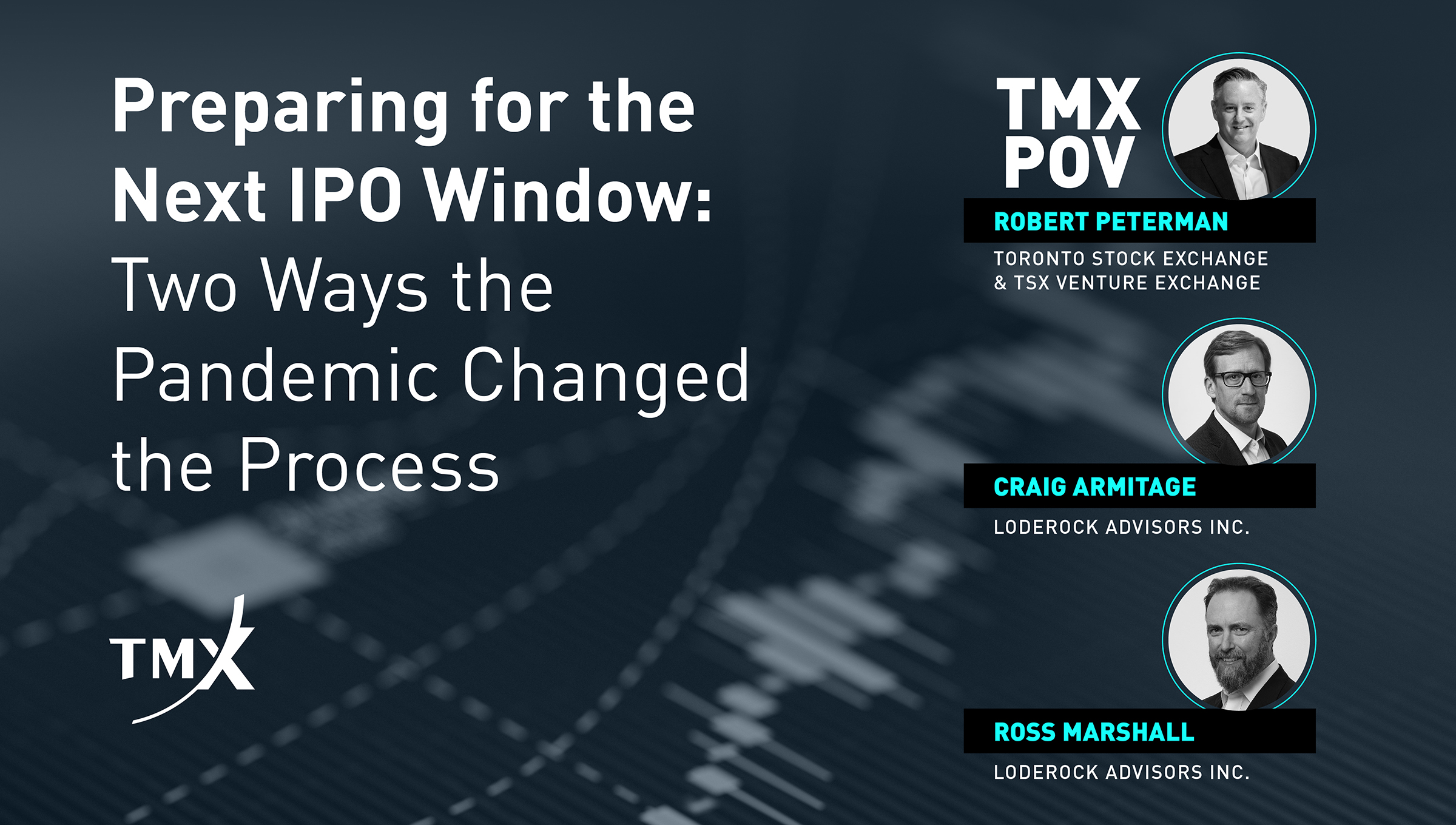TMX POV - Preparing for the Next IPO Window: Two Ways the Pandemic Changed the Process

The Next IPO Window
The last significant IPO window caught many market participants by surprise. It opened in Q3 2020 and continued through most of 2021. Almost 240 companies went public in Canada during 2021, and record amounts of capital were raised in the innovation sector. Some of the factors that created these fertile market conditions included:
- Government stimulus;
- Investor appetite for digital-first companies; and
- A willingness to pay high multiples for growth stocks.
In 2023, these things seem soundly in our rear view mirror. But we know the market for IPOs will return as it always has.
It's hard to predict exactly when we will see a more robust IPO market in Canada; however, optimists will point to a few reasons why it may come sometime soon:
- U.S. capital markets activity is typically a good leading indicator. In the second quarter of 2023, many of the U.S. IPOs have created initial value for investors, and this helps to create visibility on areas of market opportunity.
- In Canada, there was a 79% uptick in equity raised on Toronto Stock Exchange (TSX) in the second quarter of 2023 compared to Q1 2023, a clear sign of an improving environment for access to capital.
- We have a diverse group of high-quality, public-ready companies that have been waiting and building over the past 18 months and may consider capitalizing on the next IPO window.
To take advantage of these conditions when they arise, companies need to be ready. This means starting to act like a public company from a financial reporting, talent and governance perspective. Among other steps, companies should have audited annual financial statements in place, develop internal rigor around quarterly financial reporting and forecasting, take steps to build their corporate profile externally, and consider the composition and future requirements of the leadership team and Board of Directors.
Capital markets are all about timing. Being prepared from an accounting, legal and talent perspective are key steps to being positioned to take advantage of the next market window. (The TSX Guide to Listing is a good reference piece.)
How the COVID-19 Pandemic Changed IPOs
The global IPO market heated up against an unprecedented backdrop - in particular, restrictions on travel and in-person meetings. Elements of the IPO transaction that were once conducted in person quickly moved online. Added to that mix were evolutions in the regulatory environment. The combination of these two factors resulted in a speed to market – and pace of deal execution – we had never seen before. We now have a chance to reflect on these two changes and what they mean for the next cohort of IPO candidates:
1. HYBRID ROADSHOWS - When companies could no longer travel to market a transaction, IPO roadshows, like most business meetings, moved almost entirely online. This meant instead of visiting, for example, six cities in 10 days to meet with investors, a company's management team could do a higher volume of meetings in a shorter period without leaving their home offices. This took geography out of the equation, reduced costs, and made road weariness less of an issue. It also removed the constraints of complex travel schedules and coordination.
Many institutional investors have embraced the efficiency of virtual meetings and now work remotely for at least part of the week. As business travel has returned, investor marketing is now a hybrid of virtual and in-person meetings. Management teams should expect a much more focused marketing schedule anchored by in-person meetings in two or three key cities in North America, supplemented by virtual one-on-ones.
Historically, the prevailing wisdom was that investors will not write a big cheque without looking a CEO in the eyes. The past few years proved that's not the case. That said, where virtual meetings save time and money, they compromise the ability for business leaders to make meaningful connections with investors.
Takeaways for Companies
- Investors are making a bet partly on management; that hasn't changed. Where possible, management teams should still advocate to do as many in-person meetings as possible with the top targets identified by their underwriters.
- The preparation process is more complex for a hybrid roadshow. In addition to planning for one-on-one meetings and group presentations in person, management teams need to prepare to deliver a compelling pitch – and answer difficult questions – through a screen.
- After an IPO, companies need to think about their investor outreach strategy and how to nurture those investor relationships depending on whether it has been all virtual or in-person to create long-term fundamental holders.
2. TESTING THE WATERS (TTW) – In the past decade, Canadian and U.S. security regulators established and evolved rules that allow companies to "test the waters" (TTW) pre-IPO. This exemption permits non-reporting issuers, through an investment dealer, to determine interest in a potential IPO through limited confidential communication with accredited investors.
With the pandemic curtailing in-person meetings at the same time as the IPO window was opening, it presented an opportunity for investment banks to use virtual meetings to streamline the investor marketing process. Consequently, there was greater use of the TTW process during that period, often resulting in a robust investor meeting schedule before the ‘real' roadshow. In some cases, companies were meeting 30+ investors in a week during a virtual TTW.
Given this dynamic, companies were meeting many of the same investors for a second time on their actual IPO roadshow. With this in mind, companies should definitely prepare for several different meeting formats: one geared to a first meeting with a prospective investor, where the formal presentation is used to walk through the story; and a second that assumes a detailed Q&A session. Regardless of the format, being well prepared always increases the chances of a positive interaction that builds trust.
Confidential filings with Securities Regulators and the Exchanges also came into effect around this time. This became another way that the IPO process was streamlined. Pre-clearing potential issues and communicating early on with both the regulators and TSX, allows a shorter marketing period and more certainty in trying to price deals.
Success is not just about a polished pitch; companies also need to set expectations properly during the IPO process, because they will be held to these expectations and forecasts once public.
Takeaways for Companies
- Companies should get proper securities and banking advice and be thoughtful about TTW meetings and how to coordinate the process domestically or in the case where the company is doing an IPO on TSX and a US exchange.
- Companies should prepare for several different meeting formats: one geared to a first meeting with a prospective investor, where the formal presentation is used to walk through the story; and a second that assumes a detailed Q&A session.
- Companies should resist the temptation to present their ‘bull case', including in the financial models they prepare (which often provide the foundation for the IPO valuation and for the models used by the sell-side analysts who cover the company's stock once it goes public). Disappointing investors is damaging at any point, but particularly in the early days post-IPO.
Conclusions
The last IPO window saw a considerable amount of innovation. In the end, a confluence of factors created conditions under which companies could get to market faster by condensing elements of the traditional IPO process. The best advice to companies thinking about an IPO is always be ready. That's the best way to take advantage of favorable financing windows that can be unpredictable in length. New paradigms around hybrid roadshows will continue to evolve as investors, companies and bankers balance the efficiency of virtual meetings with the need to build long-term relationships.
Copyright © 2023 TSX Inc. All rights reserved. Do not copy, distribute, sell or modify this document without TSX Inc.'s prior written consent. This information is provided for information purposes only. Neither TMX Group Limited nor any of its affiliated companies guarantees the completeness of the information contained in this article, and we are not responsible for any errors or omissions in or your use of, or reliance on, the information. This article is not intended to provide legal, accounting, tax, investment, financial or other advice and should not be relied upon for such advice. The information provided is not an invitation to purchase securities listed on Toronto Stock Exchange and/or TSX Venture Exchange. TMX Group and its affiliated companies do not endorse or recommend any securities referenced in this publication. TMX, the TMX design, TMX Group, Toronto Stock Exchange, TSX, TSX Venture Exchange, The Future is Yours to See., and Voir le futur. Réaliser l'avenir. are the trademarks of TSX Inc. All other trademarks used in this article are the property of their respective owners.




